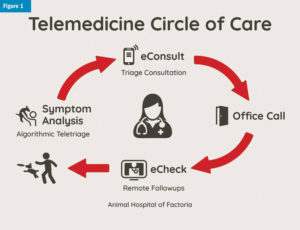
Telemedicine from the frontline: A practicing veterinarian’s perspective
To survive, we must adapt, otherwise pet parents will rely on Dr. Google, rather than wait to consult their family veterinarian
May 3, 2019 By Shlomo Freiman, DVM
Over the last decade, countless interactions with clients and patients have convinced me veterinarians must embrace telemedicine, both to remain relevant as care providers in an increasingly digital world and to compete successfully in today’s on-demand economy.
Given the change in generational demographics, today’s clients view their pets as family members and insist on immediate gratification. To survive, we must adapt, otherwise pet parents will rely on Dr. Google, rather than wait to consult their family veterinarian for advice and guidance. It was an incident with a friend and client that convinced me veterinarians, as well as pet owners and patients, can benefit enormously from the integration of telemedicine.
A tale of teletriage
Four years ago, I received an evening call from a family friend whose dog Bodhi, a mixed breed, two-year-old neutered male Labrador, suffered what seemed to be a mild seizure. While my friend was in transit to a nearby emergency animal hospital, I advised him the episode wasn’t as serious as he feared and he could wait until the next morning to bring Bodhi to my practice.
That experience of utilizing the most basic form of telemedicine—the telephone—sparked the idea of bringing the benefits of a more sophisticated telehealth solution to my practice, one that would enable me to provide the same high-level care to all my clients and patients. Since then, we have implemented an integrated teletriage platform that helps clients assess the urgency of care 24-7. The platform’s AI symptom-analysis tool informs the client and notifies me of the pet’s status. Following the algorithmic recommendation, clients can request to interact with me during set telemedicine hours.

In real time, my existing clients can upload text, pictures, and video via instant messaging within the app. This keeps me in the loop, ensuring continuous care and avoiding unnecessary ER visits. Perhaps most importantly, it strengthens my client relationships and drives business back to the brick-and-mortar hospital (Figure 1).
I’ve now featured telemedicine at my practice for almost three years. Operating under the belief telemedicine is part of standard care, we include a line item for telemedicine on the invoice of all patients’ annual exam, just as we have separate line items for data storage, file review for prescription refill, etc. As such, we nominally increased the fee of our annual exam to cover the platform’s cost.
I’ve found telemedicine has streamlined practice workflow, which improves my own work/life balance. Because I can advise clients remotely “in their living room,” I capture a significant portion of cases I otherwise would have been unaware of and would likely result in emergency room visits. The data at my practice suggests only about five percent of teletriage cases are genuine emergencies. Additionally, my team, who I rely on to assist in monitoring triage interactions, are further empowered, happier, and committed to our patients’ care beyond office hours. Further, I’ve seen better patient outcomes, as well as dramatic improvement in my relationship with clients and the financial well-being of my practice.
I share my experience because many veterinarians, especially those with longtime practices, remain suspicious of the internet as a source of reliable information. In fact, some view it as a threat to their business. Additionally, they worry about various issues related to integrating telemedicine into their practices. I, too, was initially wary of telemedicine. Like most veterinarians, I was concerned about further incursions into my personal time—I’ve seen what happens when I give my cell phone number and email address to clients.
However, disregarding client needs is not a viable option. The days in which we turn the signs on our front door to “Closed” and expect our clients to wait until morning for advice and guidance are over. This perception is supported by the findings of the Bayer Veterinary Care Usage Studies, which found the internet is the first option for information for 48 percent of pet owners when their animal is sick or injured. It is important to note this accounted for a 23 percent increase between 2010 and 2014, and has likely risen in the years since the study was last published.
The benefits of telemedicine
From talking with colleagues, I’ve learned their chief anxiety is over how to integrate telemedicine into their practice. My experience with my client Matt’s pet, Buddy—a 13-year-old mixed dachshund and longtime patient (with an ornery personality)—illuminates how a telemedicine platform can be integrated into an active veterinary practice.
One morning before our office had opened, but during our telemedicine hours, I received notification of an “urgent” recommendation made by the symptom-analysis algorithm for a chief complaint of coughing.
Chatting with Matt using the telemedicine platform’s online consulting feature, I learned he believed Buddy had contracted kennel cough from boarding a few days earlier, but was otherwise fine. I asked Matt to submit a short video of Buddy’s breathing, and to count his dog’s resting respiratory rate. A few minutes later, I was able to view the short video and learn Buddy had a regular rate and rhythm (RRR) of about 35 per minute. I suspected Buddy was slightly dyspneic.
This interaction confirmed the algorithm’s recommendation of “urgent” and the need to see Buddy that day. But Matt, expecting a very busy workday, wanted to take a wait-and-see approach, especially since Buddy was OK otherwise. He agreed, however, to keep me updated via the app and sent me another video a few hours later. By late morning, the new video showed the dyspnea was getting worse and the dog’s RRR had increased to 40 per minute.
That afternoon, Matt brought Buddy into the office; the physical exam revealed a new I/VI systolic heart murmur. Chest radiographs indicated mild-to-moderate pneumonia was the cause of Buddy’s cough. Later, an echocardiogram determined the murmur to be an incidental finding due to early-stage B1 mitral valve-related heart disease. After two days of hospitalization and intravenous antibiotics, Buddy went home happy and a little less cantankerous.
Using Buddy’s case as an example, here are the key reasons telemedicine has made a significant positive difference in my practice and in my own work/life balance. In addition to benefiting our clients and their pets, a telehealth platform can:
- Provide an adequate assessment of a pet’s situation after-hours by facilitating the gathering of symptoms and other clinical data while maintaining veterinarian-client-patient-relationship (VCPR) compliance. Telemedicine isn’t meant to replace clinical exams, but rather is a tool that helps you practice better medicine.
- Strengthen client relationships and loyalty to the veterinarian because pet owners get peace of mind knowing they can get a better and quicker assessment of their animal’s health issue(s) and gain more effective continuous veterinary care through online monitoring.
- Funnel cases to veterinarians’ brick-and-mortar hospitals, while reducing cases lost to after-hours ERs. With 75 percent of symptom analysis cases at my practice resulting in office visits, telemedicine has boosted my bottom line, while improving patient outcomes.
- Allow veterinarians to be there for their clients without being on call 24-7, enhancing work/life balance. I can customize the telemedicine hours my staff and I are available for consultation (usually a few hours before and after regular office hours). In fact, we’ve found 87 percent of symptom-analysis cases occur between 6 a.m. and 9 p.m.
- Help improve practice workflow and efficiency by allowing strategic scheduling of appointments based on information provided by telemedicine. No more last-minute calls from clients whose cat hasn’t been eating for a week.
- Keep medical records up to date by automatically uploading all information to the practice management software, unlike information gathered via phone calls, texts, and emails.
- Reduce the burden placed on front-desk staff, as well as potential conflict with clients regarding the urgency of care, by using teletriage for pre-appointment screening.
Looking at the evidence of my own practice and considering the experience of other early adopters, I am convinced telemedicine will become the standard of care in the veterinary industry. It is imperative veterinarians provide clients with innovative solutions solidifying our role as primary care providers. In a world in which the largest hospitality brand (Airbnb) owns no hotels and the largest taxi company (Uber) operates through the use of private vehicles, veterinarians must proactively embrace technology and innovation. To stay competitive, they must evolve their traditional business model and become “brick-and-click” veterinarians.
Shlomo Freiman, DVM, a graduate of Cornell University College of Veterinary Medicine and a practicing veterinarian for almost 25 years, operates Animal Hospital of Factoria, Wash. He is cofounder of the telemedicine app, Petriage. Dr. Freiman can be reached via email at [email protected].